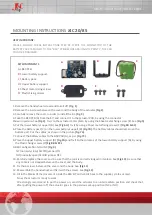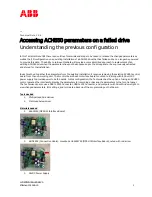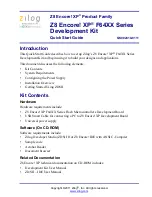
134
FORM 160.54-M1
ISSUE DATE: 10/25/2019
SECTION 13 - SOLID STATE STARTERS
JCI COMPANY CONFIDENTIAL
JOHNSON CONTROLS
the System Details line of the OptiView Control Cen-
ter display. The microboard will continue to establish
communications until successful. Also, at power-up, the
Logic/Trigger Board reads wire jumpers in its connec-
tor J1 to determine the LCSSS model applied (Refer to
Solid State Starter (Mod B) – Operation and Mainte-
nance (Form 160.00-O2)
. If an invalid jumper configu-
ration is read, the Logic/trigger Board initiates a cycling
shutdown and LCSSS - INVALID CURRENT SCALE
SELECTION is displayed on the System Details line of
the OptiView Control Center Display. The model des-
ignation is transmitted to the microboard for display on
the MOTOR Screen. This designation determines the al-
lowable range for the Full Load Amps (FLA) setpoint
and Start Current setpoint. There are 4 LCSSS models:
7L, 14L, 26L and 33L. Each model has an allowable
Full Load Amps (FLA) range and Start Current range as
listed later in this section.
Communications between the microboard and the Log-
ic/Trigger Board are in the form of master and subordi-
nate. The microboard is the master and the Logic/Trig-
ger Board is the subordinate. The Logic/Trigger Board
sends two types of data to the microboard: Status data
and Fault data.
After successful initialization, the microboard sends a
data request every 2 seconds. Normally, the Logic/Trig-
ger Board responds to each request. However, if the mi-
croboard does not receive a response to 10 consecutive
requests, the microboard initiates a cycling shutdown
and displays LCSSS - SERIAL COMMUNICATIONS
on the System Details line of the OptiView Control Cen-
ter display. In addition, the Logic/Trigger Board will ini-
tiate the same cycling shutdown if it does not receive
a data request from the microboard after 10 successive
attempts to send data.
Prior to June 2006, new production chillers are
equipped with Microboard 031-01730- 000 (early vin-
tage) or 031-02430-000 (later vintage). The COM5
(J15) serial port on these boards communicates with
the Starter Logic/Trigger Board 031-02001 (TB2) us-
After June 2006, Microboard 031-02430-001 is supplied
in new production chillers. Until March 2007, the COM
5 (J15) serial port of this board communicates with Log-
ic/Trigger Board 031-02001 (TB2) using YORK proto-
. After March 2007,
this Logic/Trigger Board is replaced with 031-02505 in
new production chillers. YORK protocol is used until
mid 2008 (See
On new production chillers after mid 2008, Microboard
031-02430-001 COM 2 (J13) serial port communi-
cates with Logic/Trigger Board 031-02505 (J14) us-
ing RS-485 Modbus protocol (See
). This configuration requires Software version
C.OPT.01.18.307 (or later). When using COM 2 serial
port for starter communications, Microboard Program
Jumper JP17 must be placed on pins 1 and 2. On the
SETUP Screen, the COM 2 serial port is enabled by
setting the Motor Communications Protocol setpoint
to Modbus. The Motor Node ID setpoint must be set
to “1” to match the Modbus Address assigned to the
starter. The Modbus Address is set to “1” in the starter
by placing Logic/Trigger Board switch SW1 position
1 to ON; all other positions to OFF. If the Motor Node
ID does not match the Modbus Address assigned to the
Logic/Trigger Board, the Logic/Trigger Board will not
communicate with the microboard.
After June 2006, and up to June 2015 Microboard
031-02430-001 was supplied as the service replace-
ment for all previous Microboards. After June 2015 the
031-03630-001 Microboard is supplied as the service
replacement for all earlier vesions. To allow it to be
backward compatible to all existing chillers, this board
contains both the COM 5 opto-coupled YORK proto-
col serial port (J15) and the COM 2 RS-485 Modbus
serial port (J13). See
After March 2007, Logic/Trigger Board 031-02505 is
supplied as service replacement for all previous Logic/
Trigger Boards. To allow it to be backward compat-
ible to all existing chillers, this board contains both an
opto-coupled YORK protocol serial port (TB2) and a
RS-485 Modbus serial port (J14). See
page 137, Figure 58 on page 137, and Figure 59 on
Anytime the Logic/Trigger Board initiates a Cycling
or Safety shutdown, it opens its STOP contacts that are
connected in series with the OptiView Control Center’s
1R (K18) RUN relay coil. The contacts remain open as
long as the condition exists. The open STOP contacts
interrupt the circuit to 1R causing it to de-energize, re-
moving the run signal to the LCSSS. Simultaneously,
the microboard reads the opening of the LCSSS STOP
contacts via the I/O Board J2- 1. This signals the mi-
croboard that the LCSSS has initiated a shutdown. The
Logic/Trigger Board sends the cause of the shutdown in
response to the next data request. This is logged on the
HISTORY Screen as the LAST FAULT WHILE RUN-
NING. A snapshot of the LCSSS operating parameters
















































